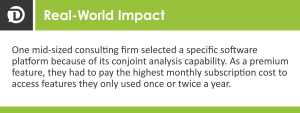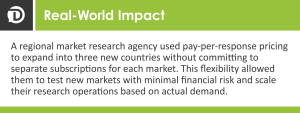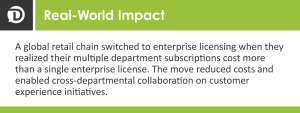When a fast-growing market research firm discovered its survey software costs had quietly ballooned to six figures annually, it realized subscription-based pricing was holding them back from expansion. This scenario plays out repeatedly across organizations of all sizes—what starts as a straightforward software decision can quickly become a strategic constraint on your business growth.
Choosing the right survey software pricing model isn’t just about managing current costs—it’s about ensuring your research capabilities can scale with your ambitions. Whether you’re conducting political polling research, market research studies, or employee feedback programs, the pricing structure you choose today will impact everything from your project planning to your ability to seize unexpected opportunities.
There are three main ways survey platforms are priced. To choose the one that best delivers on your business needs, it’s helpful to break them down and examine the pros and cons. We’ve done some of the work for you below.
Subscription-Based Pricing Overview:
Subscription-based pricing charges a recurring fee—monthly or annually—for access to the platform. Most platforms offer tiered plans, providing different levels of features and usage limits.
Pros:
• Predictable Costs: Budgeting becomes more manageable with a fixed monthly or yearly fee.</span >• Feature-Rich Plans: Higher-tier plans often include advanced analytics, integrations, and branding options.</span >• Unlimited Usage: Many subscriptions allow unlimited surveys within a set response cap, making them ideal for regular users.</span >• Scalability: Plans can often be upgraded or downgraded as needs change.
Cons:
• Underutilization: Businesses with sporadic survey needs may pay for features they don’t use.</span >• Recurring Expense: Continuous payment can add up over time, especially for smaller organizations.</span >• Tier Gaps: Some platforms’ features are locked in higher-tier plans, forcing users to pay more even if they don’t need all advanced features.

Pay-Per-Response Pricing Overview:
With pay-per-response pricing, costs are based on the number of responses collected. Users are charged per completed survey, making it a flexible option.
Pros:
• Flexibility: Ideal for businesses with unpredictable or occasional survey needs.</span >• Cost-Efficiency: You only pay for what you use, avoiding unnecessary expenses.</span >• No Long-Term Commitment: Perfect for one-time projects or seasonal campaigns.
Cons:
• Scaling Costs: Costs can escalate quickly for large-scale surveys.</span >• Unpredictable Budgeting: Response volume fluctuations can make budgeting challenging.

Enterprise Licensing Overview:
Enterprise licensing involves a fixed annual or multi-year fee for unlimited platform use across an organization. It’s tailored for large-scale or continuous survey needs.
Pros:
• Unlimited Usage: Conduct as many surveys as needed without worrying about per-survey costs.</span >• Comprehensive Features: Enterprise plans often include all advanced tools, integrations, and priority support.</span >• Centralized Access: Suitable for large teams needing shared access and collaboration.</span >• Predictable Costs: Fixed pricing allows for straightforward budgeting.
Cons:
• High Initial Investment: Costs can be prohibitive for medium and small-sized businesses.</span >• Complex Contracts: Negotiating enterprise licenses can be time-consuming.</span >• Overcommitment: Organizations with declining survey needs might still be locked into a costly contract.

How do you know if you are overspending on your survey platform?
Regular evaluation of your survey platform costs is crucial in today’s data-driven environment. Often, organizations find themselves locked into pricing models that made sense during initial selection but no longer align with their evolving needs. Whether paying for unused premium features, struggling with unpredictable response volumes, or managing multiple departmental subscriptions, identifying cost inefficiencies early can lead to significant savings. Even small overspending can compound over time, impacting your research budget and overall operational efficiency.
Here are a few tips for keeping tabs on your software expenses:
Audit Your Current Usage
• Document your monthly survey volume</span >• Track seasonal fluctuations in research needs</span >• List must-have features versus nice-to-have features</span >• Calculate your current cost per response
Ask Key Questions when Evaluating Options:
• What happens if you exceed usage limits?</span >• Are there hidden costs for data export or advanced features?</span >• How flexible are contract terms?</span >• What level of technical support is included?
Plan a Pilot Program Before Committing to a New Pricing Model:
• Request a trial period to test features</span >• Start with a small project to validate costs</span >• Document integration requirements</span >• Test mobile and offline capabilities if needed
Watch for Red Flags:
• Long-term contracts without clear exit clauses</span >• Unclear overage charges</span >• Limited data export options</span >• Restricted access to historical data</span >• Hidden fees for basic support
Making an informed decision about survey software pricing isn’t just about comparing monthly costs—it’s about choosing a model that aligns with your organization’s research goals, growth plans, and operational realities. By following these steps and carefully evaluating your needs, you can select a pricing model that not only fits your current budget but supports your future success.
Ready to move forward? Start with the audit checklist above and begin documenting your organization’s specific needs and usage patterns. You can reference our Top 5 Most Valuable Data Quality Features Your Survey Platform Must Have blog to get started. Your future self will thank you for taking the time to make this strategic decision thoughtfully.
Click here to schedule a demo with a SurveyToGo team member to learn more about SurveyToGo today.
